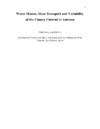Identificador persistente para citar o vincular este elemento:
https://accedacris.ulpgc.es/jspui/handle/10553/5695
| Título: | Water masses, mass transport and variability of the Canary current in autumn | Otros títulos: | Masas de agua, transporte de masa y variabilidad de la Corriente de Canarias en otoño | Autores/as: | Mock, Christina | Director/a : | Hernández-Guerra, Alonso | Clasificación UNESCO: | 251007 Oceanografía física | Palabras clave: | Corriente de Canarias Canary current Masas de agua |
Fecha de publicación: | 2011 | Proyectos: | CANIGO (MAS-CT96-0060) CORICA (REN2001-2649) Ctm2005-04701-C02-02-01/Mar. Origen de la Corriente de Canarias. |
Resumen: | CTD casts from four separate autumn cruises in 1997, 2003, 2006, and 2009 sampled the Canary Basin in order to describe the autumn characteristics of the Canary Current. To calculate geostrophic velocities and transport, a reference level of no motion of ƴn = 28.072 kg m-3 (approximately 3000 m depth) was chosen to integrate the thermal wind equation, as supported from LADCP data used from the ORCA 2009 campaign. In autumn, the average section shows a Canary Current flowing to the south at a rate of -3.6 Sv (1 Sv = 109 kg s-1) in the surface layer (0-700 m) at the latitude of the Canary Islands, from the African coast to 18ºW. This net flow is divided into a northward component of 1.1 Sv in the Lanzarote Passage (LP) and a southward component to the west of Lanzarote Island of -4.7 Sv transporting North Atlantic Central Water (NACW). In the intermediate layers (700 – 1600 m depth), Antarctic Intermediate Water (AAIW) is transported northward in the LP with 0.7 Sv. West of Lanzarote Island, the intermediate layer transport is nearly negligible although there are high energetic eddies with warm, salty Mediterranean Water (MW) presumably flowing toward the south. Deep water layers have negligible transport fluctuations, consisting of North Atlantic Deep Water (NADW) properties. While the autumn tendency is flow to the north at the surface layers in the LP, fluctuations exist from 2.2 to -1.9 Sv. However, in the intermediate layers the transport is rather consistent with variations from 0.1 to 0.7 Sv to the north, as all show AAIW features in each of the stations sampled in the LP. West of Lanzarote Island, all four cruises show a surface Canary Current component to the south ranging from -4.1 to - 5.0 Sv, with the exception of 2009 where the transport is -1.5 Sv. | Descripción: | Máster en Oceanografía | Facultad: | Facultad de Ciencias del Mar | URI: | https://accedacris.ulpgc.es/handle/10553/5695 | Derechos: | by-nc-nd |
| Colección: | Trabajo final de máster |
En el caso de que no encuentre el documento puede ser debido a que el centro o las/os autoras/es no autorizan su publicación. Si tiene verdadero interés en el contenido del mismo, puede dirigirse al director/a o directores/as del trabajo cuyos datos encontrará más arriba.
Vista completaVisitas
101
actualizado el 03-feb-2024
Descargas
53
actualizado el 03-feb-2024
Google ScholarTM
Verifica
Comparte
Exporta metadatos
Los elementos en ULPGC accedaCRIS están protegidos por derechos de autor con todos los derechos reservados, a menos que se indique lo contrario.
